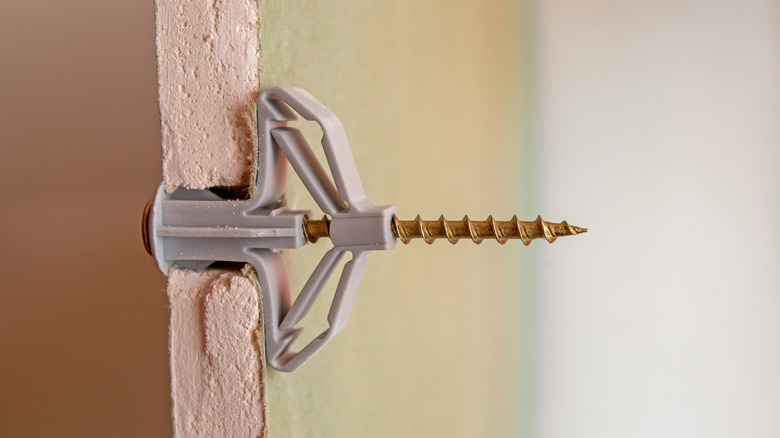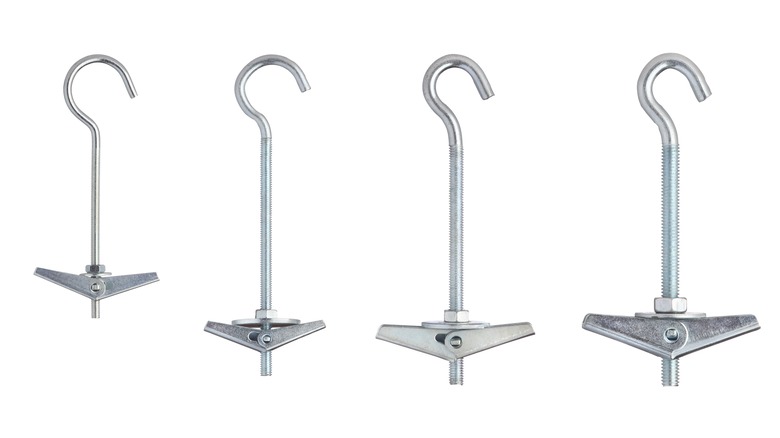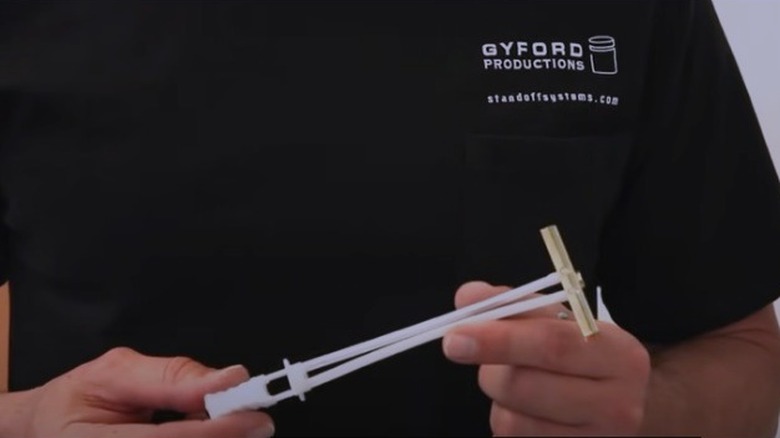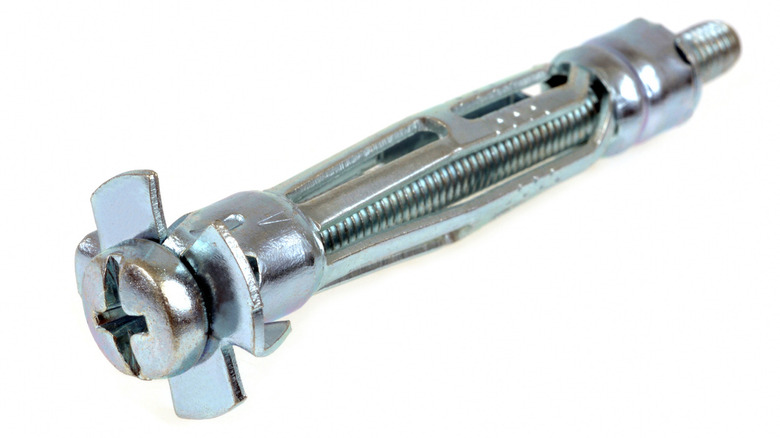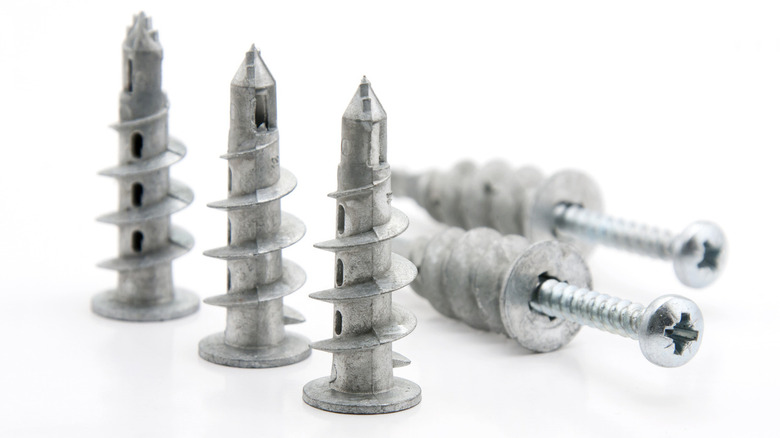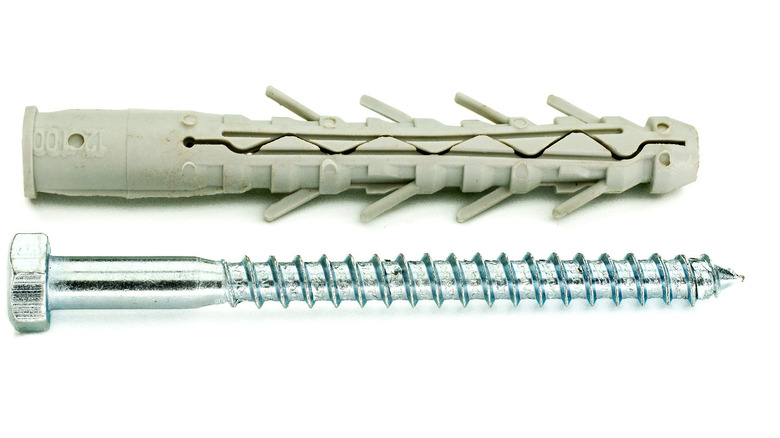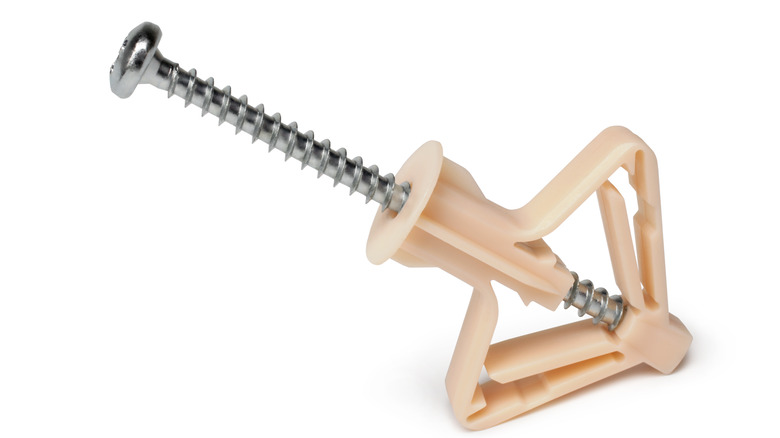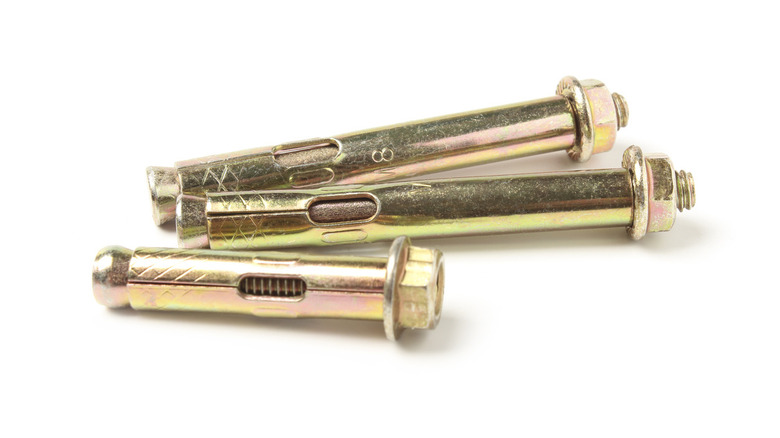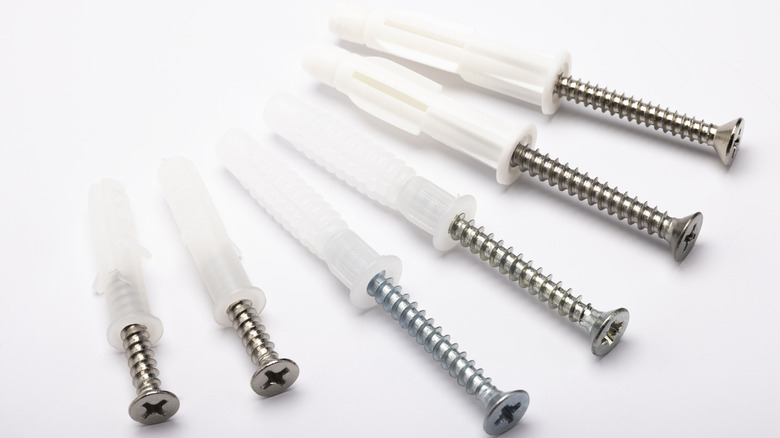What You Should Know About The 8 Types Of Drywall Anchors
Picture this: You read our post on decorating your home professionally and finally started feeling unstoppable, better-informed, and ready to execute that seemingly gargantuan task of transforming your home with a swoon-worthy look and homey feel. And as explained, you create a wall gallery, hang up a shelf, or what have you. Unfortunately, those fancy hanger screws of yours start screwing you up by slipping out of position and crashing your picture frames to the floor whenever you hang them. The horror! Can you relate? Well, don't call 911 yet.
Here's the thing: Drywall is made of compressed gypsum (a material that's not even half as strong as wood) so they're prone to crumble around nails/screws driven into them once you hang your stuff there, Homedit writes. Besides, per Remove & Replace, the tread of screws does not ordinarily latch firmly onto the holes of drywall, unlike it does in wood or concrete. So, anchors to the rescue: With them, you can confidently mount stuff firmly anywhere on any type of hollow wall. When used with appropriate screws, anchors go between your drywall and screws to create firm supports for your items while substantially securing lasting grip on the wall.
Now, the big question is which of the anchors should you go for? You'll never know until you know, right? Through the remaining part of this article, we will give you full details on eight types of drywall anchors and everything each one has to offer.
1. Toggle bolt drywall anchor
First on our list is the industrial anchor (toggle bolt) known as the "butterfly bolt" among engineers because it has "wings" that lock tightly against the backside of drywall for a lasting, pressure-defying hold, The Spruce writes. According to All Points Fasteners, a 1/2-inch thick toggle bolt anchor can singlehandedly support loads as heavy as 100 to 105 pounds in 3/4-inch thick wallboards.
So if you're mounting incredibly heavy roof gutters, window blinds, shelving or cabinets, or ceiling fans, we at House Digest recommend toggle bolts. Besides, toggles are engineered with large tough metal, making them one of the most durable household accessories that will last for years.
To install a butterfly, drill a perfect pilot hole into the wall according to the anchor size, position the wings at the top of the hole, and press in at the center of the bolt until the wings click through to spread at the back of the board. Beware and avoid getting ripped off: The average cost of an authentic toggle bolt anchor is $17!
2. Strap toggle drywall anchor
Strap toggle (AKA snap toggle anchor), unlike the traditional toggle bolt, is not extraordinarily powerful. However, it still passes for a heavy-duty cavity anchor that's super easy to work with even for a newbie DIYer. According to Powers, it has a unique one-piece design that doesn't require a screw, nail, or an additional fixture for installation: Just drill a small hole into the board, pull the carbon steel wings in, and finally strap the plastic locking cap (AKA ratchet leg).
Kitchen points out that a single 1/4-20 inch snap toggle anchor can offer reliable support to 80-pounds-weighing items on a 1/2-inch thick drywall. To that end, we at House Digest recommend strap toggles for mounting TVs of 55 inches to 77 inches; these are usually under 80 pounds. That being said, don't go too heavy on the mounting. Hang the lighter stuff here, such as mobile plants, picture frames, and then much lighter stuff like paintings and mirrors. Anyway, strap toggle drywall anchors come at an average cost of $12.
3. Steel hollow wall anchor
Rated 100% vibration-resistant by The Fastener Factory, steel hollow wall anchors provide sturdy fastening of décor to all hollow walls including plasterboards and plywood. Although never rated heavy-duty, one steel hollow wall anchor can hang 44 to 110 pounds of load like paper, says Home Depot, and can accommodate multiple reforms. Largely, you would want to consider using these for hanging décor, coat hangers, towel racks, and according to Mantel Mount, mounting a TV below 110 pounds.
Technically, a steel hollow wall anchor is a metal casing with a screw and a load-distribution washer. This three-piece fastener expands as you drive it into a cavity to hold tightly onto the inner wall of your drywall, per Home Stratosphere. According to The Spruce, a steel hollow fastener can be installed in two different ways: Lightly hit it into place with a hammer or pre-drill your wall before screwing it in for a more effortless installation. Though made of metal, most stainless steel hollow wall anchors are rust-proof to remain durable for years to come without rusting or corroding even when used to hang your bathroom-friendly art. Take note, the average cost of a steel hollow anchor is $12.
4. Self-drilling anchor
Dodge the DIY complications of operating a drilling machine by going for a self-drilling anchor (professionally known as SDA). Technically, "self-drilling" implies that these anchors have really sharp threads and sacrificial drill bits that easily cut through walls on their own. So, Pro Tool Reviews explains that all you have do is give them a little lift into your wall with the tap of a hammer, then turn the screw in with a screwdriver. Yes, that's it. And just so your home improvement store doesn't sell you short, an SDA consists of a Phillips screw, a sacrificial drill bit, hollow anchor rods, and a washer.
Ideally, Bob Vila explains one SDA should hold a total weight of about 25 pounds to 75 pounds, depending on the size of the anchor. Of course, they are not too powerful, and self-drilling anchors expand from all the hitting and drilling, so they are therefore not reusable. Based on the industry standards, self-driving anchors are mostly recommended for hanging curtains, wall clocks, photo frames, murals, partitions, shelving in a pantry, and lamps.
5. Plastic expansion anchor
Although of light-duty, plastic expansion anchors meet the average needs of a do-it-yourselfer, thanks to their unique flexibility and durability. But here comes the downside: Passing a screw through a plastic expansion anchor causes it to expand beyond reusability, says The Natural Handyman. This means that if you drive a pack of these anchors into the wrong positions and had to pull them out, say goodbyes to your $10.
It is noteworthy that plastic expansion anchors come in two types (the wing anchor and the plug anchor), each of which, according to DoItYourself, can be purchased along with special fittings to be used with picture hanging kits or a peg board. All things equal, writes Find Any Answer, a piece of plastic expansion anchor can only sustain a weight of 10 pounds on drywalls but can survive 30 pounds on concrete walls.
To install plastic expansion anchors, Hunker explains, mark the intended locations and punch holes there, then press or hammer your plastic anchors into these holes. Once done, fasten screws into the anchors with the aid of a screwdriver. Remember, holes should be smaller in size compared to the diameter of the plastic anchor.
6. Winged plastic anchor
Unlike most metallic fasteners, winged plastic anchors do not eat your drywall away neither do they come loose. They are also called nylon toggles and have plastic "wings," a wand, and a screw. As Bob Vila explains, you first pre-drill a hole, slide the anchor into that, and push the included wand right through the anchor. It is inside this setup that you drive a screw which expands the wings as you go until those wings hug tightly to the back of you drywall.
Though someone in a discussion on Stack Exchange claimed that their nylon toggle anchor has been supporting a load of 150 pounds for years without breaking a sweat, the industry standard maximum weight capacity of this plastic drywall fastener is 20 pounds. Alpha Inspections attests to this and further suggest that winged plastic anchors finds the best applications in toilets, bathrooms, or wherever there's the need for the installation of toilet paper holders, cotton rods, and towel hangers.
7. Sleeve anchor
Drywall sleeve anchoring devices are mostly applied in the installation of home electric radiators and the anchoring of public seating at events, thanks to a special design responsible for flexibility and even distribution of load-bearing weights, Fastener Mart writes. However, Alpha Inspections points out that since an anchor of this design can bear 20 to 25 pounds on drywall and 0.625 pounds affixed to a ceiling (blame that low capacity on gravity), sleeve anchors can be used for hanging heavy shelving and towel racks.
According to The Natural Handyman, sleeve anchors (made of either zinc or plastic) can be impossible to pull out once installed because an internal expander system causes the sleeve to expand and grip tightly to the hole in the wall as you drive a screw in it. Great stuff, isn't it? To install your drywall sleeve anchor you're going to need a screwdriver or a drill, a pilot hole, and of course, your anchors. Based on our market research here at House Digest, the average cost of a pack of drywall sleeve anchoring systems is $10.
8. Alligator anchor
An alligator anchor is an all-purpose anchor for holding high loads in drywall, ceilings, floors, concrete, green board, plaster, ceramic tile, foam insulated panels, and just about any other material. Toggler describes it as a tough "T" shape mold of formulated propylene which when pressed in or lightly hammered into a pre-drilled material smoothly slides in to lock into the undercut in the hole and prepare the ground for screw latching. According to Pensacola Hardware, alligator anchors out-beat most metal drywall anchors in strength; they feature anti-rotation fins and a head design that together prevent countersinking or spinning (two major problems). And, when used with stainless steel screws they offer budget-friendly, rust-free installation.
As per Toggler, a 3/16-inch alligator anchor boasts a pull-out tensile strength of 57 pounds in 1/2-inch thick drywall, while a 5/16-inch alligator anchor can bear up to 85 pounds of load in drywalls of the same thickness without damage. Anyway, alligator anchors are applicable in the installation of lighting fixtures, clotheslines, smoke detectors, cabinets, alarms, framing, speaker brackets, and even bathroom accessories.
